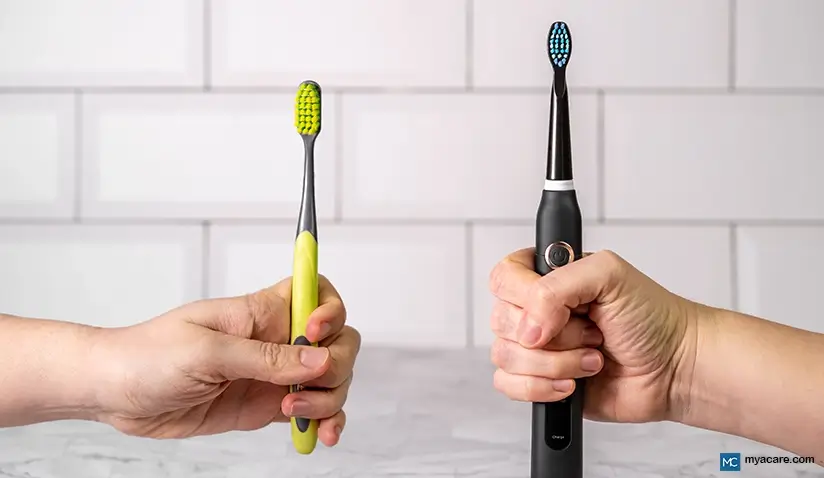Electric Toothbrush vs Manual Toothbrush, Which One Should You Use?

Toothbrushes are an essential oral hygiene tool. Manual toothbrushes are most common, with over 75% market share globally. However, electric toothbrushes promise better brushing efficiency than manual toothbrushes. The global market size of an electric toothbrush is reported to be 2.97 billion USD in 2020. Both these types of toothbrushes have several benefits and shortcomings.
This article evaluates the pros and cons of each type to help you make an informed choice.
What is a Manual Toothbrush?
A manual toothbrush is a hand-held oral hygiene aid effective in cleaning teeth. It comprises a long handle and a brush head with multiple soft bristles. Manual pressure is applied while brushing. Individuals are recommended to place the brush at an angle of 45 degrees (bristles facing the gum line) and move the bristles upwards and downwards over the teeth and gums to remove plaque and debris.
What Are the Benefits and Shortcomings of Manual Toothbrushes?
Here are some of the benefits of manual toothbrushes:
- Easily available: Manual toothbrushes are more easily available than electric toothbrushes. Individuals can buy a manual toothbrush from a grocery store, gas station, pharmacy, and dollar stores
- Easy to carry: Manual toothbrushes are easy to carry in the purse while traveling
- Affordable: A single manual toothbrush costs ~1-10 USD
- No batteries or power supply required: Manual toothbrushes do not require batteries or a power supply for their functioning
Here are some of the shortcomings of manual toothbrushes:
- Difficult to clean hard-to-reach areas: Manual brushes are difficult to use in hard-to-reach areas, especially in the third molar (wisdom tooth) regions or areas between crowded teeth.
- Difficult to control manual pressure: Manual toothbrushes do not have pressure sensors. So, individuals are likely to exert more force while using manual toothbrushes. Brushing too hard can damage the teeth and gums.
- Difficult to use for some individuals: Elderly people, people with arthritis, developmental disorders, or disabilities may lack the dexterity to perform manual brushing.
- Excess plastic waste: Manual toothbrushes should be replaced every 3 months. The entire manual toothbrush is discarded which creates excess plastic waste.
What is An Electric Toothbrush?
An electric or powered toothbrush is a battery or electricity-operated device. This device comprises a handle and a brush head with filaments or bristles. The handle contains a motor that on activation offers mechanical movement to the brush head. This enables bristles to move rapidly. This device aids in the removal of plaque (a bacterial film) and food debris from the surfaces of teeth.
Based on the type of motion and the speed of the movement of the brush head, electric toothbrushes are classified into several types.
a. Based on the type of motion:
- Vibrational electric toothbrush: In this type, the head of the electric toothbrush vibrates side-to-side which enables the removal of plaque. The brush head of this electric toothbrush resembles a manual toothbrush.
- Rotation-oscillation electric toothbrush: This type of electric toothbrush has a small and round brush head which moves in a circular motion. The head moves at a speed of 3000-7000 strokes per minute. This aids the removal of food debris and plaque from the hard-to-reach area in the mouth. It also allows easy removal of fungus which tend to develop on unclean dentures.
- Ionic toothbrush: In this type, the brush head doesn’t move. A low electric current in the bristles attracts food debris and plaque.
b. Based on the speed of the movement:
- Sonic toothbrush: This electric toothbrush uses side-to-side motion at a speed of 31,000 brush strokes per minute (~ 10 times more than a rotary brush). Bristles vibrate at a high speed which creates an audible hum within the frequency of 20 Hz to 20,000 Hz. These vibrations, in conjunction with bristles, aid in cleaning food debris and plaque. This type of electric toothbrush is most commonly used.
- Ultrasonic toothbrush: In this type, bristles vibrate at a frequency greater than 20,000 Hz. High-frequency vibration of bristles enables cleaning of debris, stains, and bacteria from the surfaces of teeth.
What are the Benefits and Shortcomings of Electric Toothbrushes?
Here are some of the benefits of electric toothbrushes:
- Effective in plaque removal: The presence of a specially designed brush head and 3D brushing motion features allow easy access and effective cleaning of all the surfaces of teeth. So, they are considered more effective in plaque removal.
- Better ease of use: Battery or electricity-operated toothbrushes require less effort compared to manual ones. This is helpful in individuals with limited mobility of fingers due to various conditions such as arthritis, carpal tunnel syndrome, developmental disorders, or individuals with long-term hospitalization or who are physically handicapped. It is also easy to use in individuals with braces.
- Presence of additional features: Electric toothbrushes have various features which improve the efficacy of cleaning and minimize the trauma to the soft tissues (e.g., gums) in the mouth. For instance, a built-in timer that snoozes after 2 minutes or after 30 seconds as a reminder to brush teeth only for 2 minutes or for 30 seconds in each quadrant of the mouth. Most modern electric brushes have pressure sensors that produce a sound warning or stop when the brush is used aggressively. The addition of features such as Bluetooth connectivity and different cleaning modes that are specialized for sensitive teeth, whitening action, or gum massaging further enhance the efficiency of electric toothbrushes.
- Less plastic wastage: Unlike manual toothbrushes, most electric toothbrushes do not require complete replacement (except single-use electric toothbrushes). Only the head of the electric toothbrush is replaced.
- Child-friendly: Children who lack the skill and motivation to use manual brushes can easily brush their teeth using electric toothbrushes. These brushes are more engaging for children and aid in oral hygiene maintenance.
Here are some of the shortcomings of electric toothbrushes:
- Expensive: The cost of electric toothbrushes may vary from USD 30-250 compared to less than USD1-10 for manual toothbrushes. The brush heads of electric toothbrushes require replacement every three months just like the manual brushes. The cost of a pack of multiple brush heads ranges between USD 10-45
- Loud: During usage, electric toothbrushes are louder than manual ones which may annoy some users.
- Risk of damaging tooth surface: Individuals who exert more force while using electric toothbrushes may damage the surface of teeth, causing sensitivity.
Should You Prefer an Electric Toothbrush over a Manual Toothbrush?
Both manual and electric toothbrushes are effective in cleaning teeth. However, some short- and long-term studies have reported 11% and 21% higher plaque removal efficiency of electric toothbrushes compared to manual brushes. This may not be a reflection of the efficacy of the manual toothbrush itself, but is driven by inadequate training of users on proper brushing techniques.
Choosing the correct type of manual brush along with the right technique while brushing can yield results similar to electric toothbrushes. However, more time and effort are required in manual brushing compared to electric toothbrushes. Electric toothbrushes make brushing easier, enabling better plaque removal.
With the increase in disposable incomes, the global market share of electric toothbrushes is projected to grow from USD 3 billion in 2021 to USD 4 billion in 2028.
Based on the individual’s needs and desires, the dentist can also help decide which type is more suitable. Irrespective of the type of brush, an individual should be well-versed with the correct brushing technique, and use additional interdental aids to maintain oral health.
To search for the best dentists in Germany, India, Malaysia, Poland, Singapore, Spain, Thailand, Turkey, the UAE, the UK and the USA, please use the Mya Care search engine.
To search for the best healthcare providers worldwide, please use the Mya Care search engine.

Dr. Shilpy Bhandari is an experienced dental surgeon, with specialization in periodontics and implantology. She received her graduate and postgraduate education from Rajiv Gandhi University of Health Sciences in India. Besides her private practice, she enjoys writing on medical topics. She is also interested in evidence-based academic writing and has published several articles in international journals.
References:
Featured Blogs



